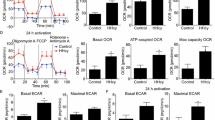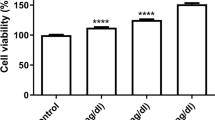Abstract
Activated peripheral blood mononuclear cells (PBMC) release homocysteine and possess cystathionine β-synthase (CBS) activity; however, it was thought that there is no CBS in resting state. Previously, we found that nickel decreased intracellular homocysteine concentration in un-stimulated (e.g. resting) PBMC, suggesting that resting PBMC might also have active homocysteine metabolism. Here, we demonstrated that un-stimulated PBMC synthesize (incorporate l-[methyl-14C]methionine to DNA, lipids and proteins), release (increase extracellular homocysteine), and metabolize homocysteine. Intracellular homocysteine concentration varied with incubation time, depending on extracellular concentrations of methionine, homocysteine, and glutathione. Methionine synthase activity was constant and independent of thiol concentrations. In Western blot, CBS protein was clearly identified in freshly isolated PBMC. CBS protein level and activity increased with incubation time, upon stimulation, and similar to intracellular homocysteine, depending on intra- and extracellular homocysteine and glutathione concentrations. According to our knowledge, this is the first evidence that certifies homocysteine metabolism and regulatory role of CBS activity to keep balanced intracellular homocysteine level in resting PBMC. Homocysteine, released by PBMC, in turn can modulate its functions contributing to the development of hyperhomocysteinemia-induced diseases.







Similar content being viewed by others
References
Banerjee RV, Matthews RG (1990) Cobalamin-dependent methionine synthase. FASEB J 4:1450–1459
Banerjee R, Zou CG (2005) Redox regulation and reaction mechanism of human cystathionine-beta-synthase: a PLP-dependent hemesensor protein. Arch Biochem Biophys 433:144–156
Barathi S, Vadhana P, Angayarkanni N, Ramkrishnan S (2007) Estimation of hydrogen sulphide in the human lymphocytes. Indian J Biochem Biophys 44:179–182
Blanco RA, Ziegler TR, Carlson BA, Cheng PY, Park Y, Cotsonis GA, Accardi CJ, Jones DP (2007) Diurnal variation in glutathione and cysteine redox states in human plasma. Am J Clin Nutr 86:1016–1023
Boyum A (1968) Isolation of mononuclear cells and granulocytes from human blood. Scand J Clin Lab Invest 21:77–89
Chanarin I, Deacon R, Lumb M, Muir M, JPerry J (1985) Cobalamin-folate interrelations: a critical review. Blood 66:479–489
Crott J, Fenech M (2001) Preliminary study of the genotoxic effect of homocysteine in human lymphocytes in vitro. Mutagenesis 16:213–217
Crott J, Thomas P, Fenech M (2001) Normal human lymphocytes exhibit a wide range of methionine-dependency which is related to altered cell division but not micronucleus frequency. Mutagenesis 16:317–322
Delgado-Reyes CV, Wallig MA, Garrow TA (2001) Immunohistochemical detection of betaine-homocysteine S-methyltransferase in human, pig, and rat liver and kidney. Arch Biochem Biophys 393:184–186
Devi SK, Devi ARR, Kondaiah P (1998) Amplification of phenylalanine hydroxylase and cytathionine β-synthase transcripts in human peripheral lymphocytes by RT-PCR. Biochem Mol Bio Intern 45:643–650
Drummond JT, Jarrett J, González JC, Huang S, Matthews RG (1995) Characterization of nonradioactive assays for cobalamin-dependent and cobalamin-independent methionine synthase enzymes. Anal Biochem 228:323–329
Fensom AH, Benson PF, Crees MJ, Ellis M (1983) Prenatal exclusion of homocystinuria (cystathionine β-synthase deficiency) by assay of phytohaemagglutinin-stimulated lymphocytes. Prenat Diagnosis 3:127–130
Gartler SM, Hornung SK, Motulsky AG (1981) Effect of chronologic age on induction of cystathionine synthase, uroporphyrinogen I synthase, and glucose-6-phosphate dehydrogenase activities in lymphocytes. PNAS 78:1916–1919
Goldstein JL, Campbell BK, Gartler SM (1972) Cystathionine synthase activity in human lymphocytes: induction by Phytohemagglutinin. J Clin Invest 51:1034–1037
Guttormsen AB, Solheim E, Refsum H (2004) Variation in plasma cystathionine and its relation to changes in plasma concentrations of homocysteine and methionine in healthy subjects during a 24-h observation period. Am J Clin Nutr 79:76–79
Hadzic T, Li L, Cheng N, Walsh SA, Spitz DR, Knudson CM (2005) The role of low molecular weight thiols in T lymphocyte proliferation and IL-2 secretion. J Immunol 175:7965–7972
Hamelet J, Ait-Yahya-Graison E, Matulewicz E, Noll C, Badel-Chagnon A, Camproux AC, Demuth K, Paul JL, Delabar JM, Janel N (2007) Homocysteine threshold value based on cystathionine beta synthase and paraoxonase 1 activities in mice. Eur J Clin Invest 37:933–938
Hamilos DL, Zelarney P, Mascali JJ (1989) Lymphocyte proliferation in glutathione depleted lymphocytes: direct relationship between glutathione availability and the proliferative response. Immunopharmacology 18:223–235
Ignoul S, Eggermont J (2005) CBS domains: structure, function, and pathology in human proteins. Am J Physiol Cell Physiol 289:C1369–C1378
Katko M, Kiss I, Karpati I, Kadar A, Matyus J, Csongradi E, Posta J, Paragh G, Balla J, Kovacs B, Varga Z (2008) Relationship between serum nickel and homocysteine concentration in hemodialysis patients. Biol Trace Elem Res 124:195–205
Kery V, Poneleit L, Kraus JP (1998) Trypsin cleavage of human cystathionine beta-synthase into an evolutionarily conserved active core: structural and functional consequences. Arch Biochem Biophys 355:222–232
Korendyaseva TK, Martinov MV, Dudchenko AM, Vitvitsky VM (2010) Distribution of methionine between cells and incubation medium in suspension of rat hepatocytes. Amino Acids 39:1281–1289
Lowry OH, Rosebrough NJ, Farr A, Randall RJ (1951) Protein measurement with the Folin phenol reagent. J Biol Chem 193:265–275
McCully KS, Wilson RB (1975) Homocystein theory of arteriosclerosis. Atherosclerosis 22:215–227
Minagawa H, Watanabe A, Akatsu H, Adachi K, Ohtsuka C, Terayama Y, Hosono T, Takahashi S, Wakita H, Jung CG, Komano H, Michikawa M (2010) Homocysteine, another risk factor for Alzheimer disease, impairs apolipoprotein E3 function. J Biol Chem 285:38382–38388
Morrow G 3rd, Barness LA (1972) Combined vitamin responsiveness in homocystinuria. J Pediatr 81:946–954
Mosharov E, Cranford MR, Banerjee R (2000) The quantitatively important relationship between homocysteine metabolism and glutathione synthesis by the transsulfuration pathway and its regulation by redox changes. Biochemistry 39:13005–13011
Prudova A, Bauman Z, Braun A, Vitvitsky V, Banerjee R (2006) S-adenosylmethionine stabilizes cystathionine β-synthase and modulates redox capacity. PNAS 103:6489–6494
Reed MC, Thomas RL, Pavisic J, James SJ CM, Ulrich CM, Nijhout HF (2008) A mathematical model of glutathione metabolism. Theor Biol Med Model 5:8. doi:10.1186/1742-4682-5-8
Schroecksnadel K, Frick B, Kaser S, Wirleitner B, Ledochowski M, Mur E, Herold M, Fuchs D (2003a) Moderate hyperhomocysteinemia and immune activation in patients with rheumatoid arthritis. Clin Chim Acta 338:157–164
Schroecksnadel K, Frick B, Wirleitner B, Schennach H, Fuchs D (2003b) Homocysteine accumulates in supernatants of stimulated human peripheral blood mononuclear cells. Clin Exp Immunol 134:53–56
Selhub J (1999) Homocysteine metabolism. Ann Rev Nutr 19:217–246
Suthanthiran M, Anderson ME, Sharma VK, Meister A (1990) Glutathione regulates activation-dependent DNA synthesis in highly purified normal human T lymphocytes stimulated via the CD2 and CD3 antigens. Proc Natl Acad Sci USA 87:3343–3347
Svatikova A, Wolk R, Magera MJ, Shamsuzzaman AS, Phillips BG, Somers VK (2004) Plasma homocysteine in obstructive sleep apnoea. Eur Heart J 25:1325–1329
Tsai MS, Bignell M, Schwichtenberg K, Hanson N (1996) High prevalence of a mutation in the Cystathionine β-synthase gene. Am J Hum Genet 59:1262–1267
Ubbink JB, Hayward Vermaak WJ, Bissbort S (1991) Rapid high-performance liquid chromatographic assay for total homocysteine levels in human serum. J Chromatogr 565:441–446
Van Dam F, Van Gool WA (2009) Hyperhomocysteinemia and Alzheimer’s disease: A systematic review. Arch Gerontol Geriatr 48:425–430
van Guldener C, Stehouver CD (2000) Hyperhomocysteinemia, vascular pathology, and endothelial dysfunction. Sem Thromb Hemost 26:281–289
Velez-Carrasco W, Merkel M, Twiss CO, Smith JD (2008) Dietary methionine effects on plasma homocysteine and HDLmetabolism in mice. J Nutr Biochem 19:326–370
Vitvitsky V, Mosharov E, Tritt M, Ataullakhanov F, Banerjee R (2003) Redox regulation of homocysteine-dependent glutathione synthesis. Redox Rep 8:57–63
Wallberg-Jonsson S, Cvetkovic JC, Sundqvist KG, Lefvert AK, Rantapaa-Dahlqvist S (2002) Activation of the immune system and inflammatory activity in relation to markers of atherothrombotic disease and atherosclerosis in rheumatoid arthritis. J Reumatol 29:875–882
Zhang Q, Zeng X, Guo J, Wang X (2001) Effects of homocysteine on murine splenic B lymphocyte proliferation and its signal transduction mechanism. Cardiovasc Res 52:328–336
Zou CG, Banerjee R (2003) Tumor necrosis factor-alpha-induced targeted proteolysis of cysthationine beta-synthase modulates redox homeostasis. J Biol Chem 278:16802–16808
Acknowledgments
Research was sponsored by the Hungarian Scientific Research Fund (Grant numbers OTKA T 22739 and T 48596). We thank to Professor Gabriella Foris (Head of Experimental Laboratory, Health and Medical Science Centre, University of Debrecen) who provide confluent HepG2 cells.
Conflict of interest
None of the authors shares any conflict of interest or is consultants for companies.
Author information
Authors and Affiliations
Corresponding author
Rights and permissions
About this article
Cite this article
Katko, M., Zavaczki, E., Jeney, V. et al. Homocysteine metabolism in peripheral blood mononuclear cells: evidence for cystathionine beta-synthase activity in resting state. Amino Acids 43, 317–326 (2012). https://doi.org/10.1007/s00726-011-1080-2
Received:
Accepted:
Published:
Issue Date:
DOI: https://doi.org/10.1007/s00726-011-1080-2




